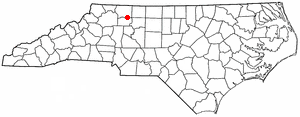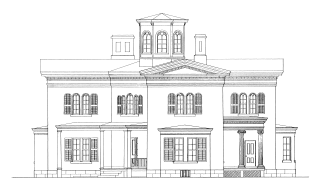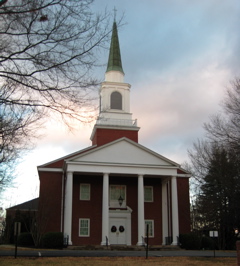
Montgomery County is a rural county located in the southern Piedmont of the U.S. state of North Carolina. As of the 2020 census, the population was 25,751. Its county seat is Troy.

Yadkin County is a county located in the U.S. state of North Carolina. The population was 37,214 at the 2020 census. Its county seat is Yadkinville. Yadkin County is included in the Winston-Salem, NC Metropolitan Statistical Area, which is also included in the Greensboro–Winston-Salem–High Point, NC Combined Statistical Area.

Surry County is a county located in the U.S. state of North Carolina. As of the 2020 census, the population was 71,359. Its county seat is Dobson, and its largest community is Mount Airy.

Rowan County is a county in the U.S. state of North Carolina that was formed in 1753, as part of the British Province of North Carolina. It was originally a vast territory with unlimited western boundaries, but its size was reduced to 524 square miles (1,360 km2) after several counties were formed from Rowan County in the 18th and 19th centuries. As of the 2020 census, its population was 146,875. Its county seat, Salisbury, is the oldest continuously populated European-American town in the western half of North Carolina. Rowan County is located northeast of Charlotte, and is considered part of the Charlotte-Concord-Gastonia, NC-SC Metropolitan Statistical Area.

Iredell County is a county located in the U.S. state of North Carolina. As of the 2020 census, the population was 186,693. Its county seat is Statesville, and its largest community is Mooresville. The county was formed in 1788, subtracted from Rowan County. It is named for James Iredell, one of the first justices of the Supreme Court. Iredell County is included in the Charlotte-Concord-Gastonia, NC-SC Metropolitan Statistical Area, as defined by the Office of Management and Budget, with data from the U.S. Census Bureau.

Davidson County is a county located in the U.S. state of North Carolina. As of the 2020 census, the population was 168,930. Its county seat is Lexington, and its largest community is Thomasville.

Albemarle is a city in and the county seat of Stanly County, North Carolina, United States. The population was 16,432 in the 2020 census.

East Bend is a town in northeastern Yadkin County, North Carolina, United States. The population is 634 at the 2020 census. It is a Piedmont Triad community.

Cooleemee, also known as the Cooleemee Plantation House, is a house located between Mocksville and Lexington, North Carolina, at the terminus of SR 1812 on the Yadkin River in Davie County, North Carolina. It is a U.S. National Historic Landmark, designated in 1978 for its architecture.
Yadkin College was a college founded in 1857 by the Methodist Protestant Church. It was located in rural Davidson County, North Carolina and named for the nearby Yadkin River. High Point University serves as the successor to Yadkin College.

Richmond Mumford Pearson, Jr. was an American diplomat and member of the U.S. House of Representatives from North Carolina.

Richmond Mumford Pearson was an American jurist who served as chief justice of the North Carolina Supreme Court from 1859 to 1878. He was the father of Congressman Richmond Pearson and the father-in-law of North Carolina Governor Daniel Gould Fowle.

William Henry Harrison Cowles was a North Carolina Democratic politician who served four terms in the United States House of Representatives.

Rockford is an unincorporated community and former town in southern Surry County, North Carolina, United States.
Richmond Hill is an unincorporated community in northern Yadkin County, North Carolina, United States, along the Yadkin River. The community is on the Yadkin County side of the river between the Surry County communities of Rockford and Siloam. It is located in the Boonville ZIP code area (27011).
Donnaha is an unincorporated community along the Yadkin River in the Old Richmond Township of northwest Forsyth County, North Carolina, United States. Donnaha is named for the last chief of the Sauras.

Enon is an unincorporated community in eastern Yadkin County, North Carolina, United States. The community, which is centered on Enon Baptist Church, is in the Forbush Township and in the East Bend ZIP code zone (27018). It is a Piedmont Triad community.

Cumnock, formerly known as Egypt, is an unincorporated community in northwestern Lee County, North Carolina, United States. It lies on Cumnock Road, about a mile north of U.S. Route 421.

The Fountain, also known as Walnut Fountain and the Colonel Davenport House, is a historic plantation home located at Yadkin Valley, Caldwell County, North Carolina. It was built in 1807, and is a two-story, T-shaped frame dwelling with Federal and Greek Revival style design elements. Also on the property is a contributing brick well house/dairy.

Fort Defiance is a historic plantation house located near Lenoir, Caldwell County, North Carolina. The main block was built between 1788 and 1792, and is a two-story, frame structure measuring 28 feet by 40 feet. A wing was added in 1823. It was the home of Revolutionary War General William Lenoir. The property was transferred to the Caldwell County Historical Society in 1965 and operated as a historic house museum.




















